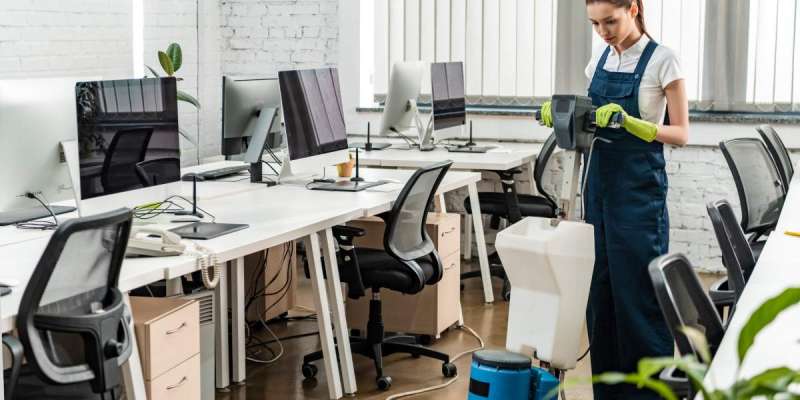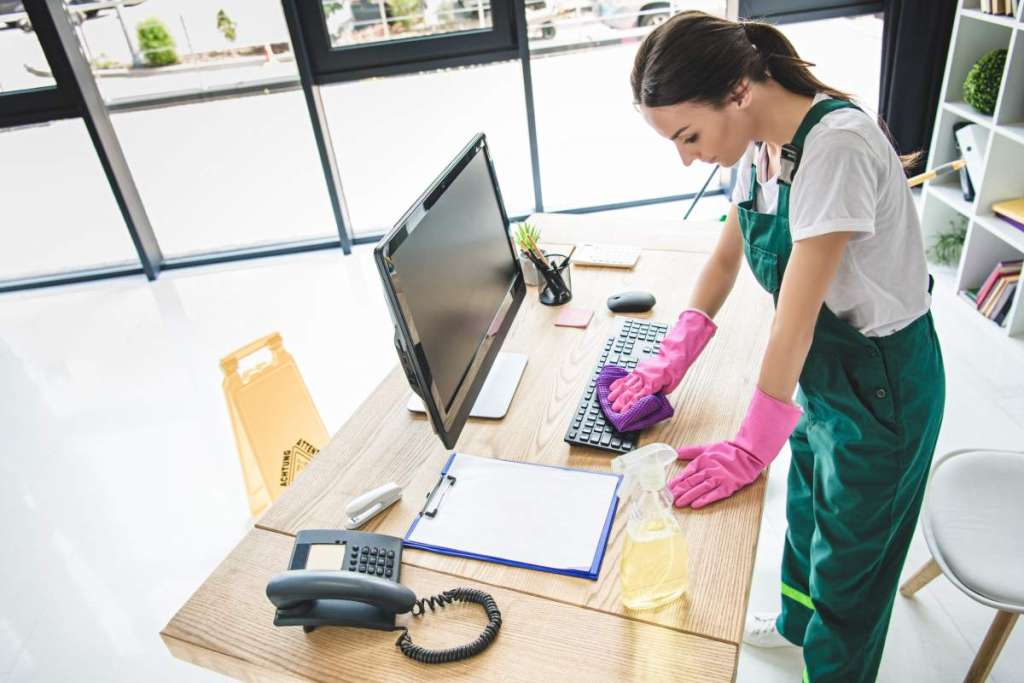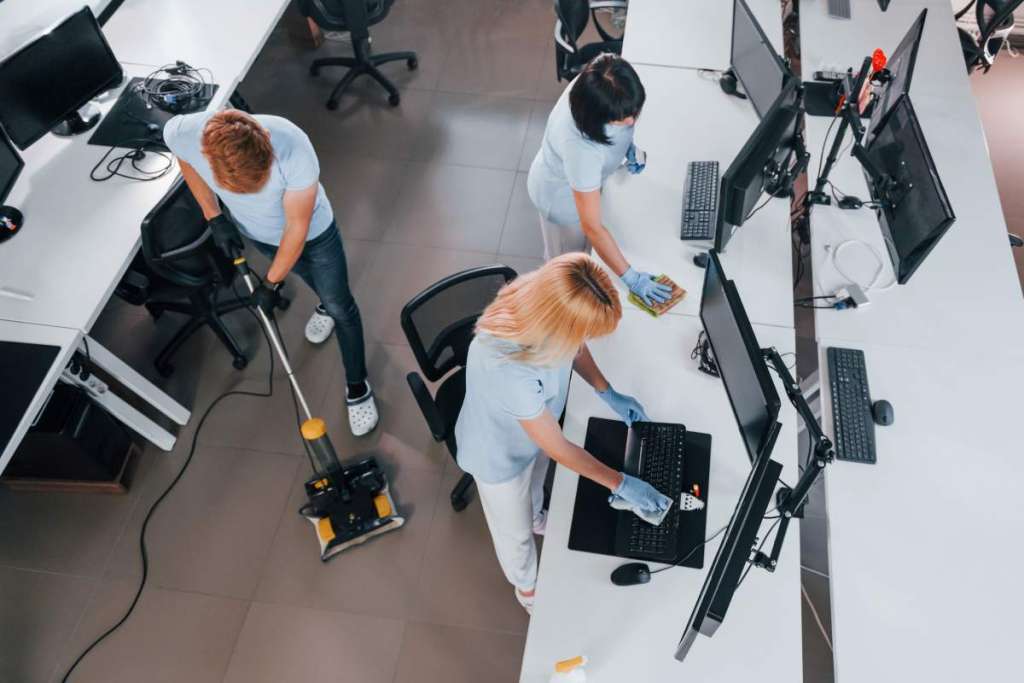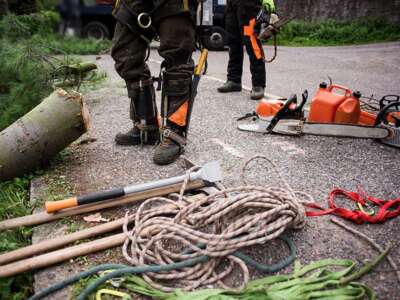Maintaining a clean office environment is essential for the health, productivity, and overall well-being of employees. A well-kept office not only creates a positive impression for clients and visitors but also plays a critical role in preventing the spread of germs and fostering a more organized, efficient workspace.
From individual workstations to common areas and high-touch surfaces, each part of the office requires specific attention to ensure that the environment remains safe, hygienic, and conducive to work. Understanding which areas need the most focus and why they are important can help in creating a cleaning routine that meets the needs of your workplace.
Why is Office Cleaning Important?
Office cleaning is crucial for several reasons, affecting both the physical environment and the well-being of employees. A clean office isn’t just about aesthetics; it’s about creating a productive, healthy, and welcoming space for everyone who works there. Here’s why office cleaning is so important:
1. Health and Safety
A clean office reduces the spread of germs and bacteria, which can cause illnesses among employees. Regular cleaning and disinfecting of surfaces like desks, keyboards, and doorknobs help prevent the transmission of colds, flu, and other contagious diseases.
When an office is not regularly cleaned, dust, mould, and allergens can accumulate, leading to respiratory issues and other health problems. By maintaining a clean environment, companies can ensure the health and safety of their employees, reducing sick days and promoting overall business and well-being.
2. Increased Productivity
A cluttered and dirty workspace can be distracting and demotivating for employees. When an office is clean and organized, it creates a more pleasant working environment, allowing employees to focus better and be more productive.
A well-maintained office also helps in reducing stress levels, as employees do not have to worry about cleaning up or dealing with a disorganized space. This leads to a more positive work atmosphere where employees can thrive.
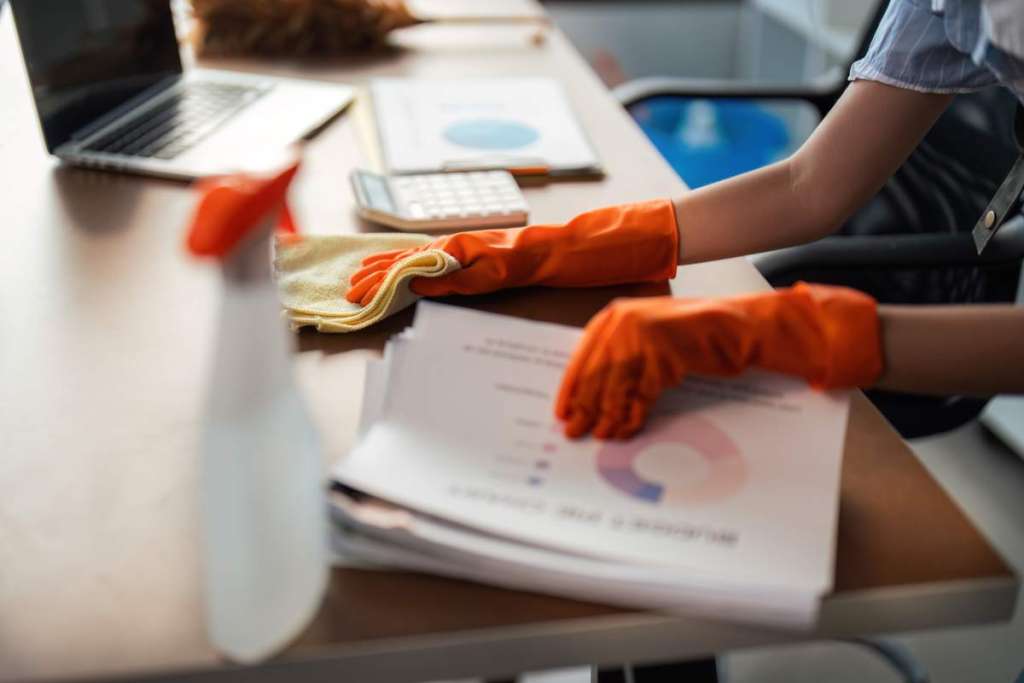
3. Professional Image
The appearance of an office is a reflection of the company itself. A clean and well-maintained office gives a positive impression to clients, visitors, and potential business partners. It shows that the company values professionalism and cares about its environment.
On the other hand, a dirty or untidy office can create a negative perception, making clients and visitors question the company’s attention to detail and overall professionalism. Keeping the office clean helps maintain a good reputation and can even influence business success.
4. Long-Term Cost Savings
Regular cleaning and maintenance of office spaces can help prevent long-term damage to furniture, carpets, and equipment. Dirt, dust, and grime can cause wear and tear on office materials, leading to the need for repairs or replacements sooner than expected. By investing in regular cleaning, companies can extend the life of their office assets and avoid costly repairs or replacements down the line.
This is particularly important for expensive equipment and office furniture that are essential to daily operations.
5. Employee Morale
A clean and well-maintained office can significantly boost employee morale. When employees see that their workplace is taken care of, it instils a sense of pride and belonging. They are more likely to take care of their own spaces and contribute to maintaining a clean environment.
High morale leads to higher job satisfaction, lower turnover rates, and a more cohesive team. In contrast, a dirty or neglected office can lead to low morale, disengagement, and a lack of motivation among staff.
6. Compliance with Regulations
In some industries, maintaining a clean office is not just a matter of preference but a legal requirement. Health and safety regulations often mandate certain standards of cleanliness, especially in sectors like healthcare, food services, and manufacturing.
Failing to comply with these regulations can result in fines, legal issues, and damage to the company’s reputation. Regular cleaning ensures that the office meets all necessary regulations and avoids any potential legal complications.
What Kind of Office Cleaning Do You Need?
The type of office cleaning you need depends on the size of your office, the industry you’re in, and specific needs or preferences. Here’s a breakdown of the different types of office cleaning services that might be necessary:
1. Daily Cleaning
Daily cleaning is essential for maintaining a basic level of cleanliness and hygiene in the office. This typically includes:
- Trash Removal: Emptying trash cans and recycling bins to keep the office tidy and prevent odours.
- Surface Cleaning: Wiping down desks, tables, and other surfaces to remove dust and grime.
- Floor Care: Vacuuming carpets and mopping hard floors to keep them clean and presentable.
- Restroom Cleaning: Ensuring that restrooms are sanitized, stocked with supplies, and free of unpleasant odours.
- Kitchen/Break Room Cleaning: Cleaning countertops, sinks, and appliances like microwaves and refrigerators.
2. Weekly or Bi-Weekly Cleaning
For a deeper clean, you might consider weekly or bi-weekly services, which can include:
- Detailed Dusting: Dusting high surfaces like shelves, light fixtures, and vents that aren’t addressed in daily cleaning.
- Window Cleaning: Cleaning interior windows and glass doors to remove smudges and streaks.
- Disinfecting High-Touch Areas: Focusing on sanitizing doorknobs, light switches, and shared office equipment like printers and copiers to reduce the spread of germs.
- Deep Carpet Cleaning: A more thorough vacuuming or shampooing of carpets to remove dirt, stains, and allergens.
3. Monthly or Periodic Cleaning
Some tasks only need to be done on a monthly or less frequent basis. These might include:
- Deep Cleaning: A comprehensive cleaning that covers all areas, including those that aren’t usually addressed in daily or weekly cleaning, like behind furniture or under heavy equipment.
- Floor Polishing: Buffing and polishing hard floors to restore their shine and protect them from wear and tear.
- Upholstery Cleaning: Cleaning and refreshing office chairs, sofas, and other upholstered furniture to remove stains and odours.
- High-Level Dusting: Reaching and cleaning high surfaces, like ceiling fans, air vents, and light fixtures, that gather dust over time.
4. Specialized Cleaning
Depending on your industry, you might require specialized cleaning services:
- Medical Office Cleaning: If your office is in the healthcare industry, you’ll need specialized cleaning to meet strict hygiene standards. This includes the use of hospital-grade disinfectants and protocols to prevent cross-contamination.
- Industrial Cleaning: For offices in manufacturing or industrial sectors, cleaning might involve dealing with more significant debris, grease, and specific safety requirements.
- Post-Construction Cleaning: If your office has recently been renovated or constructed, a post-construction cleaning service will be necessary to remove dust, debris, and construction materials, ensuring the space is safe and ready for use.
5. Green Cleaning
If environmental sustainability is a priority for your company, you might opt for green cleaning services. This involves:
- Eco-Friendly Products: Using cleaning products that are non-toxic, biodegradable, and environmentally friendly.
- Sustainable Practices: Implementing cleaning practices that reduce waste, conserve water, and minimize energy use.
6. Event Cleaning
If your office hosts events, you may need specialized cleaning before and after these gatherings. Event cleaning typically includes:
- Pre-Event Preparation: Setting up clean and organized spaces before the event, ensuring all areas are presentable.
- Post-Event Cleanup: Cleaning up after the event, which may involve removing trash, rearranging furniture, and deep cleaning areas that were heavily used.
What Are the Most Important Areas to Clean in an Office?
When cleaning an office, certain areas are particularly important to maintain for health, safety, and productivity reasons. These areas can harbour germs, accumulate dirt, or impact the overall impression of the workspace. Here are the most important areas to focus on:
1. Desks and Workstations
- Surface Cleaning: Desks are high-touch areas where employees spend most of their time. Regularly wipe down surfaces, including the desk itself, computer keyboards, mice, and phones.
- Organizing Clutter: Keep workstations tidy by organizing papers, office supplies, and personal items. A clutter-free desk is more efficient and easier to clean.
2. Common Areas
- Reception Area: This is the first area visitors and clients see, so keeping it clean is crucial. Regularly vacuum or mop floors, dust surfaces, and arrange seating neatly. Clean the reception desk and ensure any magazines or promotional materials are tidy.
- Break Rooms and Kitchens: These areas can quickly become messy and are prone to spills and food debris. Clean countertops, tables, and appliances like microwaves, refrigerators, and coffee machines daily. Make sure sinks are cleaned and dishes are not left out.
- Meeting Rooms: Clean tables, chairs, and any equipment like projectors or remote controls. Dust surfaces and vacuum floors to keep the space presentable for meetings with clients or team members.
3. Restrooms
- Sanitization: Restrooms must be cleaned and sanitized daily to maintain hygiene. Clean toilets, sinks, and mirrors thoroughly. Ensure that soap dispensers, toilet paper, and paper towel holders are fully stocked.
- Odour Control: Use air fresheners or cleaning products that help control odours. Regular cleaning of tiles and grout can prevent the buildup of mould and mildew, which can contribute to unpleasant smells.
4. High-Touch Areas
- Doorknobs and Handles: These are among the most frequently touched surfaces in an office and can be hotspots for germ transmission. Disinfect doorknobs, handles, and light switches regularly.
- Elevator Buttons: If your office has an elevator, the buttons should be cleaned frequently, as they are touched by multiple people throughout the day.
- Shared Office Equipment: Printers, copiers, and fax machines are often used by many employees, making them important to clean. Disinfect these devices regularly to prevent the spread of germs.
5. Floors and Carpets
- Vacuuming and Sweeping: Carpets and floors collect dust, dirt, and debris that can affect air quality and create an unkempt appearance. Vacuum carpets and sweep or mop hard floors regularly.
- Spot Cleaning: Address spills and stains as soon as they occur to prevent permanent damage to carpets and floors.
6. Windows and Glass Surfaces
- Window Cleaning: Clean windows allow natural light to enter the office, creating a brighter and more pleasant work environment. Regularly clean both the interior and exterior of windows to remove smudges, dirt, and streaks.
- Glass Doors and Partitions: If your office has glass doors or partitions, keep them clean to maintain a professional look. These surfaces can easily show fingerprints and smudges, so regular cleaning is essential.
7. Trash Bins
- Emptying Trash Bins: Trash bins should be emptied daily to prevent odours and overflowing. Ensure that recycling bins are also emptied and that the office follows proper waste disposal practices.
- Cleaning the Bins: Periodically clean and sanitize the trash bins themselves to remove any lingering odours or bacteria.
8. Air Vents and HVAC Systems
- Dusting and Cleaning Vents: Dust and allergens can accumulate in air vents, affecting air quality. Clean vents regularly to ensure that the office air remains fresh and healthy.
- Changing Filters: Regularly replace filters in HVAC systems to maintain good air circulation and reduce the spread of airborne contaminants.

